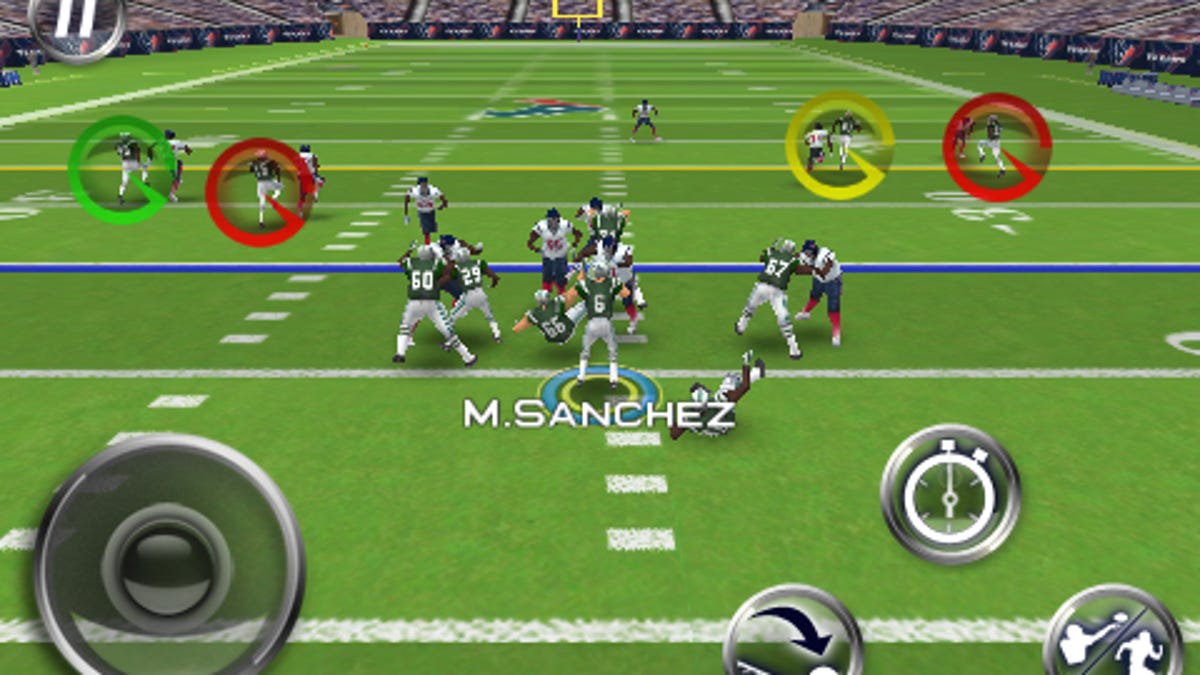iPhone NFL Kick off: Does Madden 10 play nice without buttons?
The Madden juggernaut hits the iPhone, but is it the same experience without physical buttons?

The real NFL season is about to kick off, and EA has seized the opportunity to finally slide in the release of its much-anticipated port of Madden to the iPhone/iPod Touch format. It represents the meeting of the mobile entertainment industry's unstoppable force, Apple's black slab of wonder, with the gaming industry's immovable object. Available at $7.99 through the kickoff of the Steelers-Titans game tonight and $9.99 afterward, is it worth your hard-earned tailgate dollars? We played it last week here at the CNET offices and played it a lot more on our own iPhone last night, and here's our verdict.
It took EA a few weeks longer to get its iPhone act together than Gameloft did with NFL 2010. Did it pay off? Well, in some ways, yes. The player models and 3D stadiums seem better rendered than Madden's NFL-licensed and similarly-named App Store rival, NFL 2010 by Gameloft, but with a significant drawback: the framerate on our 3GS playthrough was significantly choppier than NFL 2010. A future update will hopefully fix this, but in the meantime it doesn't affect gameplay enough to be a game-killer. The presentation and commentary are impressive, nearing console level but hovering nearer to PSP and DS versions of Madden.
The biggest fear among those who play any type of hardcore game is whether losing a physical control pad affects gameplay in any significant way. The answer is simple: yes, it does. I've played games on my iPhone for more than a year, and it rarely avoids feeling like a compromise: lose a control pad, but gain a simplified interface and an extremely compact form in a smartphone. As to whether it's worth it, ask yourself if you'd rather tote around a PSP or a Nintendo DS in your pocket in addition to your phone, or just carry an iPhone and lose a few controls, and you'll have your answer.
The solution EA has given is the same many developers have, including Gameloft: add a virtual stick in the lower left corner, and a series of context-sensitive buttons in the lower right. The problem with the virtual stick is that, like other titles, it can be lost in the shuffle on heavy-focus moments of game play. There's no tactile feedback, so it must be looked after, unlike a real analog pad. When playing Madden, that means a lot of the accuracy is lost. But the good news is that this game wasn't really designed for finesse play. We'll explain.
When plays are called via a series of nesting touch menus, the ensuing play unfolds kind of like a regular game of Madden you'd expect on a console: players line up, you can select linemen or receivers by cycling or tapping directly, and a few presnap shifts are possible. It's nowhere near the level of a console game, or even many handheld games, but for a mobile device without physical buttons it certainly isn't bad. One particularly great new feature in the iPhone/iPod Touch iteration of Madden 10 is a direct touch-to-draw method for creating instant hot routes for receivers. It's so fun and easy that it potentially redefines the notion of playcalling, since drawing your own plays is so instantaneous as opposed to the button-menu systems on consoles. It resembles what's available on the Wii version, but even more immediately gratifying. After tweaks have been made, snapping is a matter of tapping anywhere onscreen, then tapping to open receivers to throw--or in the event that it's a run, controlling the back and making a few moves (turbo, spin, etc.).
When a critical moment is reached on offense or defense, a special slowdown button brings up a new selection of more-specific action buttons. As opposed to NFL 2010 by Gameloft, which forced the slowdown before critical plays and offered only a few options, Madden opens up the selection process to more buttons and makes the pressing of the slowdown button entirely your decision. This means dumb, fast gameplay or more slowed-down tweaking to hit holes are both ways to play, and both work reasonably well. In fact, sometimes the game feels a little like real console football. On an iPhone and with a price tag of $10, that's a good accomplishment.
Having slowdown means that the virtual analog stick and buttons can be more easily located in those critical moments, allowing EA to sidestep the virtual controller difficulties in many speed-oriented games. It also means this Madden is beginner-friendly, possibly for the first time in years.
Season mode and quickplay options are available, but no franchise or multiplayer yet. EA has hinted at multiplayer coming in an update soon, as well as paid DLC such as new uniforms and roster updates (though we hope those roster updates are free). Madden costs $7.99 until this evening's NFL season kickoff, then rises to a more normal $9.99. As we said with Gameloft's NFL 2010, that's peanuts for sports fans who are used to spending $8 on a dry hot dog. And for our final recommendation between both games: while the race was tight, the overall play controls on Madden 10 edge out NFL 2010 this year. Better late than never. For next year, we hope Gameloft keeps competing and keeping EA honest, and we hope these control issues get ironed out even further--until the iPhone gets its mythical control pad, at least.

